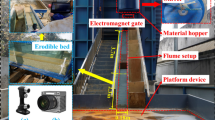Abstract
The 2008 Wenchuan Earthquake in SW China in the Sichuan Province generated many co-seismic landslides, which delivered a huge amount of loose co-seismic landslide deposits. It caused a dramatic increase in debris flow occurrence in the subsequent years. The mechanism of these runoff debris flows has not been completely understood. The study of the complexity of the phenomenon, such as runoff-induced erosion in initially unsaturated granular deposits, and damming and breaching effects caused by instability in gully banks due to erosion, requires the use of a well-equipped flume. To this aim, an instrumented flume was built at Chengdu University of Technology for the study of the initiation mechanism. Advanced equipment such as the 3D laser scanner was used to monitor the change in tomography of the slope during the test. And some sensors for unsaturated soils such as TDR and tensiometers were installed to capture the change of hydraulic properties of soil. Especially, the erosion was analyzed quantitatively by collecting the washing-out material every 20 s. The preliminary experimental results are very encouraging for investigating the initial mechanism of debris flow. The erosion curve was obtained, and the damming and breaching effect was found to be of key importance to the initiation process.
















Similar content being viewed by others
References
Anderson SA, Sitar N (1995) Analysis of rainfall-induced debris flows. J Geotech Eng 121(7):544–552
Berti M, Simoni A (2005) Experimental evidences and numerical modeling of debris flow initiated by channel runoff. Landside 2(3):171–182
Campbell RH (1975) Soil slips, debris flows, and rainstorms in the Santa Monica Mountains and vicinity, Southern California. US Geol Survey Prof Paper No 851:51
Cannon SH, Gartner JE, Parrett C, Parise M (2003) Wildfire-related debris flow generation through episodic progressive sediment bulking processes, western USA. In: Rickenmann D, Chen CL (eds) Proceedings of the third international conference on debris-flow hazards mitigation. Davos, Switzerland, pp 71–82
Egashira S, Honda N, Itoh T (2001) Experimental study on the entrainment of bed material into debris flow. Phys Chem Earth Part C: Sol Terr Planet Sci 26(9):645–650
Iverson RM (1990) Groundwater flow fields in infinite slopes. Géotechnique 40(1):139–143
Iverson RM, Reid ME, Logan M, LaHusen RG, Godt JW, Griswold JP (2011) Positive feedback and momentum growth during debris-flow entrainment of wet bed sediment. Nat Geosci 4:116–121
Montgomery DR, Dietrich WE (1994) A physically based model for the topographic control on shallow landsliding. Water Res Res 30(4):1153–1171
Olivares L, Damiano E (2007) Postfailure mechanics of landslides: laboratory investigation of flowslides in pyroclastic soils. J Geotech Geoenvironmental Eng 133(1):51–62
Pack RT, Tarboton DG, Goodwin CN (1998) Terrain stability mapping with SINMAP, technical description and users guide for version 1.00. Terratech Consulting Ltd, Salmon Arm, BC, Canada, Report Number 4114–0:68
Sidle RC, Swanston DN (1982) Analysis of a small debris slide in coastal Alaska. Can Geotech J 19(2):167–174
Tang C, Zhu J, Li WL (2009) Rainfall-triggered debris flows following the Wenchuan earthquake. Bull Eng Geol Environ 68(2):187–194
Tang C, van Asch TWJ, Chang M, Chen GQ, Zhao XH, Huang XC (2012) Catastrophic debris flows on 13 August 2010 in the Qingping area, southwestern China: the combined effects of a strong earthquake and subsequent rainstorms. Geomorphology 139–140:559–576
Tognacca C, Bezzola GR, Minor HE (2000) Threshold criterion for debris-flow initiation due to channel bed failure. In: Wieczoreck GF (ed) Proceedings second international conference on debris flow hazards mitigation: mechanics, prediction and assessment, Taipei, pp 89–97
Vincenzo D, Matteo C, Lorenzo M (2010) Field and laboratory investigations of runout distances of debris flows in the Dolomites (Eastern Italian Alps). Geomorphology 115(3–4):294–304
Xu Q, Zhang S, Li WL, Van Asch ThWJ (2012) The 13 August 2010 catastrophic debris flows after the 2008 Wenchuan earthquake, China. Nat Hazards Earth Syst Sci 12(1):201–216
Acknowledgments
This research is financially supported by the National Basic Research Program “973” project of the Ministry of Science and Technology of the People’s Republic of China (2013CB733200); National fundamental scientific research Grant (No, 41102188); public welfare project from Ministry of Land and Resources of People’s Republic of China (2013-11122); National Science Found for Distinguished Young Scholars of China (Grant No. 41225011), and the Chang Jiang Scholars Program of China.
Author information
Authors and Affiliations
Corresponding author
Rights and permissions
About this article
Cite this article
Hu, W., Xu, Q., Rui, C. et al. An instrumented flume to investigate the initiation mechanism of the post-earthquake huge debris flow in the southwest of China. Bull Eng Geol Environ 74, 393–404 (2015). https://doi.org/10.1007/s10064-014-0627-3
Received:
Accepted:
Published:
Issue Date:
DOI: https://doi.org/10.1007/s10064-014-0627-3




